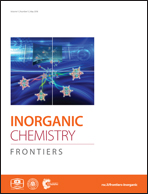Hollow NiFe2O4 microspindles derived from Ni/Fe bimetallic MOFs for highly sensitive acetone sensing at low operating temperatures†
Abstract
Hollow semiconductor oxide micro-/nanomaterials can provide significant advantages for gas sensing by facilitating the diffusion of target gases and the surface reaction. In this study, we report the synthesis of hollow NiFe2O4 microspindles through an as-developed metal–organic framework (MOF) route, which involves two steps: the preparation of Ni/Fe bimetallic MOF solid microspindle precursors and their subsequent transformation to the final materials via an annealing treatment in the air. The hollow NiFe2O4 microspindles were demonstrated to be composed of primary nano-building particles and abundant deep pores in the hollowed-out shells. Furthermore, in synergy with the large specific surface area, hollow interior, and abundant surface oxygen species, as expected, the gas sensor based on the hollow NiFe2O4 microspindles delivered a high sensitivity of 52.8 towards 200 ppm acetone vapor as well as good selectivity and cyclic stability at a low working temperature (120 °C). Finally, the sensing mechanism for the gas sensing behavior was also proposed. The high-performance sensing behavior towards acetone suggests that the as-fabricated sensor can be a promising candidate for environmental monitoring; thus, this study paves the way towards the efficient fabrication of advanced gas sensors on the basis of metal oxides derived from appropriate MOF precursors in the future.



 Please wait while we load your content...
Please wait while we load your content...